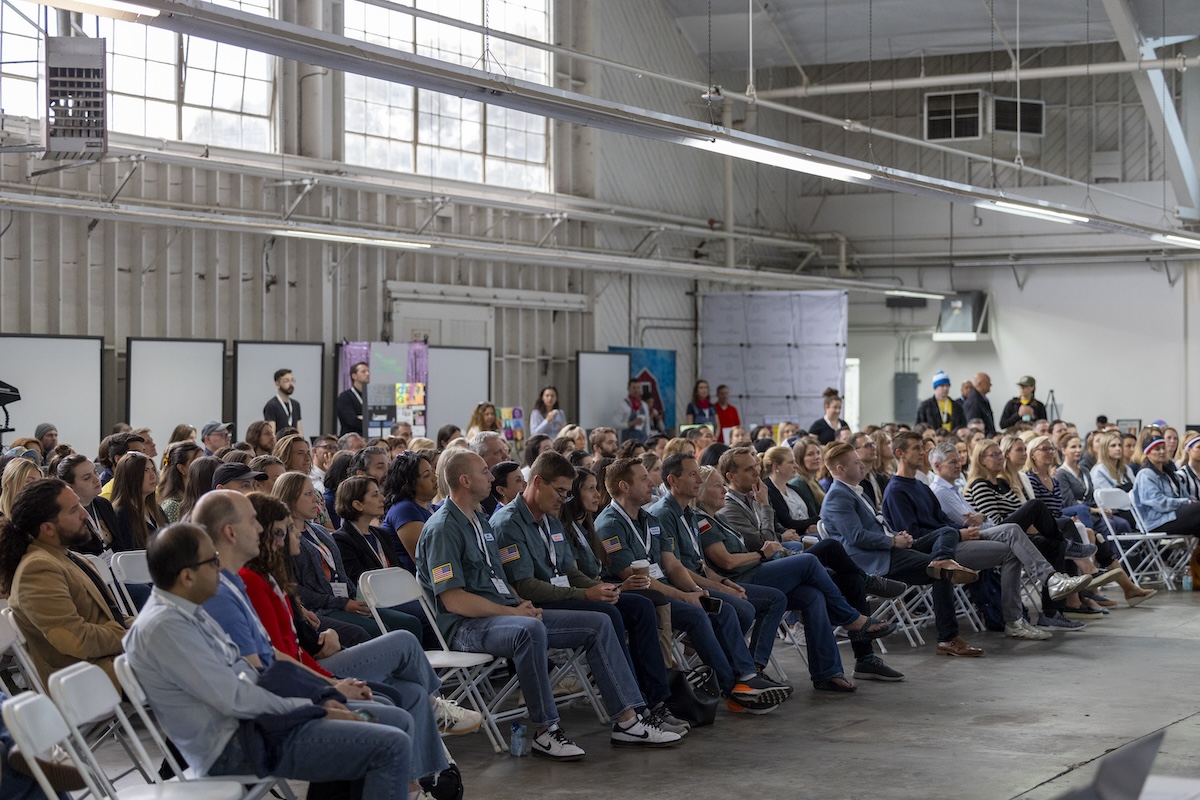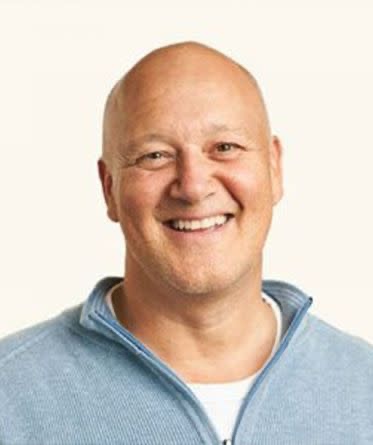Kate Farms Plants the Flag

Brett Matthews is showing me around Kate Farms’ Innovation and Quality Center, a lab and office complex the size of an airplane hangar. Bewilderingly complex machines festooned with tubes are being tended to by folks in clean room suits. We stop outside a sealed central workspace and stare through a glass wall. The largish, inelegant contraption in the middle of the floor could’ve been cobbled together by Dr. Seuss.
“We don’t manufacture here,” Mathews yells over the mild roar of the place. “We make a little beaker full of product – a sample which has the right proteins and fats and vitamins and other ingredients – and we take that into this machine.”
Matthews is a former MUS Board President, serial entrepreneur, vanguard nutritional advocate and, since 2015, CEO of Kate Farms; a little operation that is parlaying the plant kingdominto high-octane metabolic rescue.
“That machine basically produces eight gallons worth of product,” Matthews says. “We have six manufacturing facilities in the U.S. and one in Canada – literally a million square feet. These systems are huge. So this is a miniaturized version.” He nods at Seuss. “It mixes and pasteurizes the formula and allows us to make sure that the tastes are right. So we can adjust and perfect based on eight gallons versus 8,000 gallons.” None of this is a dry entrepreneurial exercise for my host.
Hands-on and Jacuzzi-free

Brett Matthews is not one of those all-purpose CEOs to which we and Forbes have grown accustomed – an over-caffeinated corporate puppeteer with a C-Suite-tooth and singular focus on shareholder value. As CEO (and parent), Matthews does not issue remote commands from a penthouse office with a full bar and jacuzzi. He is acutely immersed in Kate Farms’ humane mission and in the people who help him execute – a cohort who refer to themselves as Kate Farmers. Here he is now, standing next to me and staring through glass with the unconscious smile of an eight-year-old showing off his baseball cards.
“We want to make sure, of course, that what was produced is what it’s supposed to be.” He nods at the Seuss contraption. “And then we do hang tests with different pumps. So we test for product flow through the pump and the purity of the ingredients. And of course that it tastes good.”
What sort of plant-derived foodstuff needs to both taste good and flow efficiently through a pump? Hellooooo Kate Farms. “We’ve got full-time technicians in here,” Mathews says. “We work with food scientists, molecular biologists, food safety experts…”
This plant-based evangelism all sounds very tie-dyed but has in fact long been the subject of endless peer-reviewed papers by such rumor mills as the National Institutes of Health; and the metabolic gifts of the plant kingdom began field testing about 2,000 years before paper itself was invented. “We know bad food can make you sick,” Matthews says. “Our whole thesis is that good food and plant-based nutrition can heal.”
Plant Life is Life
The sun blasts the earth with solar energy, our adorable home planet turning on its axis like a rotisserie chicken to receive an even coating of the cosmic largesse. 430 quintillion joules of energy bathe the planet every hour; a little more energy than all of humankind uses in a year. Earth’s verdant shag carpet – the Plant Kingdom – is energy’s first stop; the first trophic level in the food chain. From there, the story is one of pure loss, thanks to a sorrowful and annoying rule of biophysics called the “10% Rule of Energy Transfer.” 90% of the energy available at one trophic level is lost in the transfer to the next. Eat the bunny that ate the grass and you’re getting 10% of the energy the bunny got. Which is all to say, the plant kingdom is where all the undiluted energy lives. What if that could be bottled?
“I went to Proctor & Gamble in healthcare marketing out of college,” Matthews says when we sit down to talk. “Then my wife and I started a business together when we were about 25, which created public-private partnerships with federal and state governments. We sold that business in 2005 (to Pitney Bowes).” All that slice of life happened in Massachusetts. “So we moved out here from Boston, had our children and took a break – dove into nonprofit work, education, did some investing. That’s where I got involved in the Montecito Union School Board –” where Matthews was MUS Board President.
“And then along the way, in eighth grade my oldest son Skyler started getting sick.” Matthews pauses. “I learned about nutrition by being a dad.” He learned it the hard way. “Skyler got progressively sicker and sicker and sicker. His junior year in high school he was playing varsity water polo at Santa Barbara High School, pushing his body really hard. He was pretty wiped out. It was almost like he had a chronic pneumonia.” The doctors couldn’t figure it out. A friend mentioned a clinic in Switzerland.
“The place was a natural biological medicine clinic, homeopathic, research-backed. I took Skyler over there and in eight days they figured out his primary issue and got him on a path to healing. A lot of it was around functional ingredients, intravenous and oral, to build up his microbiome. When I came back to the States I said, ‘wow, what a great opportunity to bring this idea of nutrition into healthcare.’ Because not one of these doctors we talked to ever really mentioned nutrition as a frontline.”
Pharmasynthesis: Hold the Sun Inside
Richard and Michelle, meanwhile, had brought their Katie into the world. Their beautiful and spirited daughter was soon found to have cerebral palsy. The condition made it difficult for Katie to feed, and the off-the-shelf liquid replacement diet offered by the hospital was not nourishing her. Her frustrated and desperate parents couldn’t help but notice that the formula they’d been given for Katie listed water, sugar, corn syrup, maltodextrin and casein as the first five ingredients. By the age of five she weighed 16 pounds.
Walking through the Santa Barbara farmers market one day, surrounded by the massively displayed rainbow of unfiltered plant energy, Richard and Michelle idly daydreamed jamming the energized, nutrient-rich plants into Katie’s feeding tube and thence into her hungry furnace. Working from this idle epiphany, Richard approached a friend, a vegan chef. Following 70 iterations and tests and restarts and tweaks, they arrived at formula #71. Katie’s response was dramatic – improved energy, clear eyes, a blush on her cheeks. Voila. Katie recently turned 18 and is flourishing.
“Richard and Michelle actually started the product in small retail shops,” Matthews says. “But the idea was really to take this into the healthcare marketplace. And then I became chairman, and then CEO soon thereafter.” Under Matthews’ proactive direction, Kate Farms has optimized nature’s most combustible ingredients in specific formulations across several categories, medicalized and otherwise: Everyday Nutrition, Medical Nutrition, Kids Nutrition, and Specialized Nutrition. These have been taken up by some 1,450 hospitals and several of the largest health systems in the USA.
Kate Farms’ ethos is based on something once murmured by a balding guy in a toga. “Let Food Be Thy Medicine and Medicine Be Thy Food.” Hippocrates – the Classical era’s so-named father of modern medicine – had nourishment dialed in 24 centuries ago. We have been disastrously slow on the uptake. Kate Farms is resoundingly filling the gap with a formulation that can flow through a feeding tube or be gulped from a frosted highball glass.
“We’re talking about food as medicine,” Matthews says. “And when an opportunity of entrepreneurship presents itself and it has to do with helping other people, that’s as exciting as it gets.”







You must be logged in to post a comment.